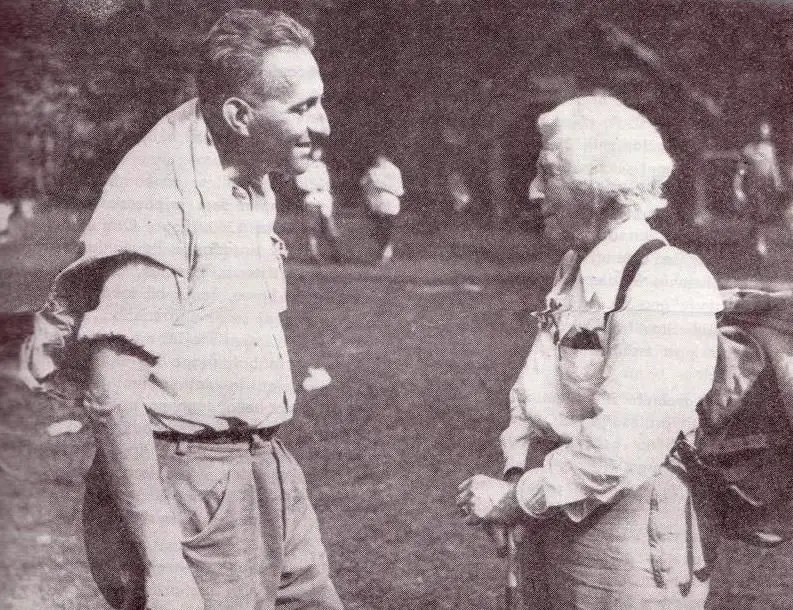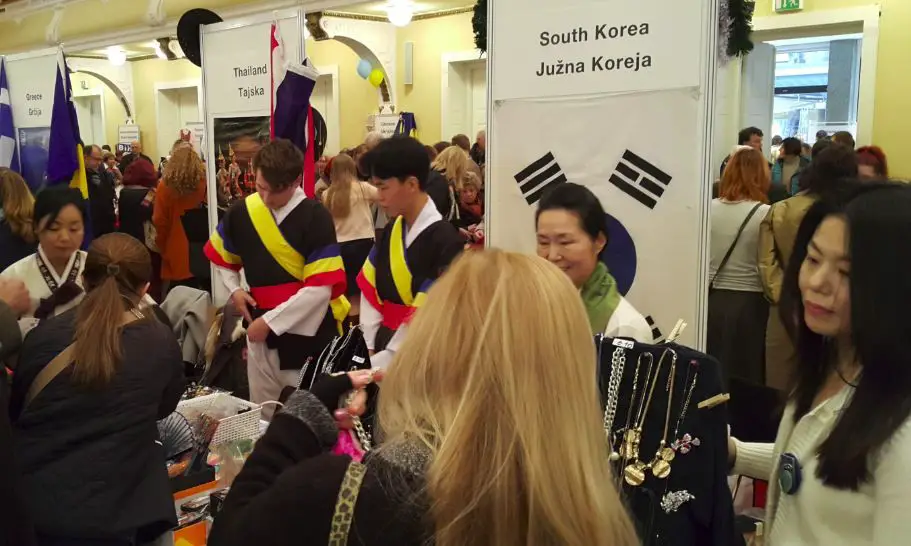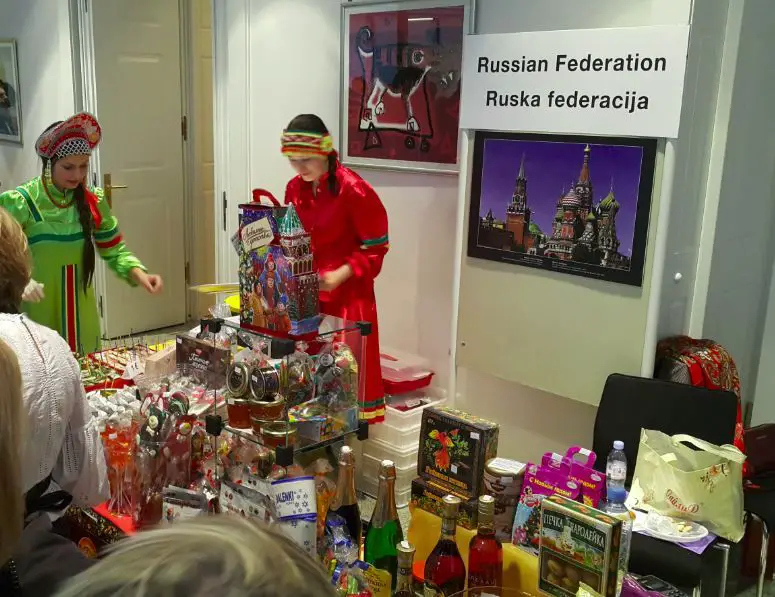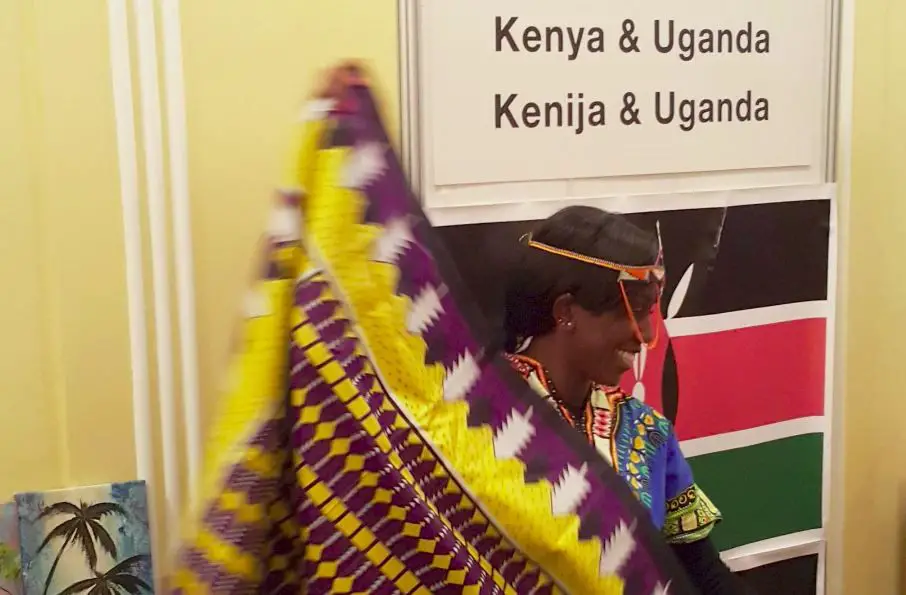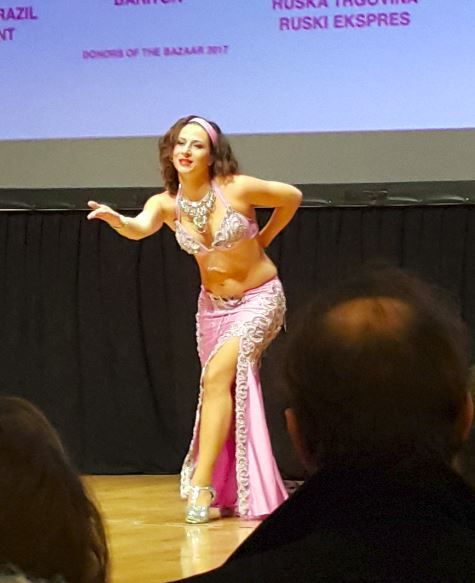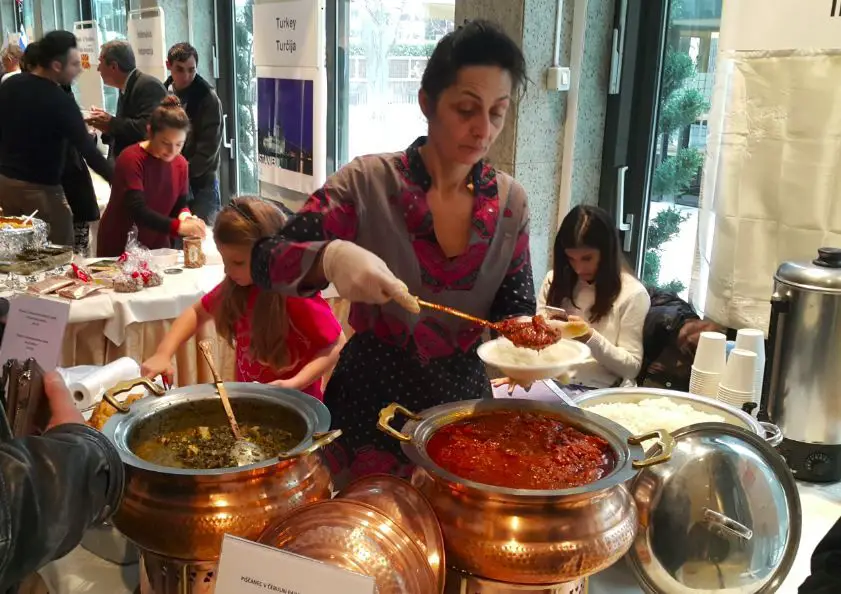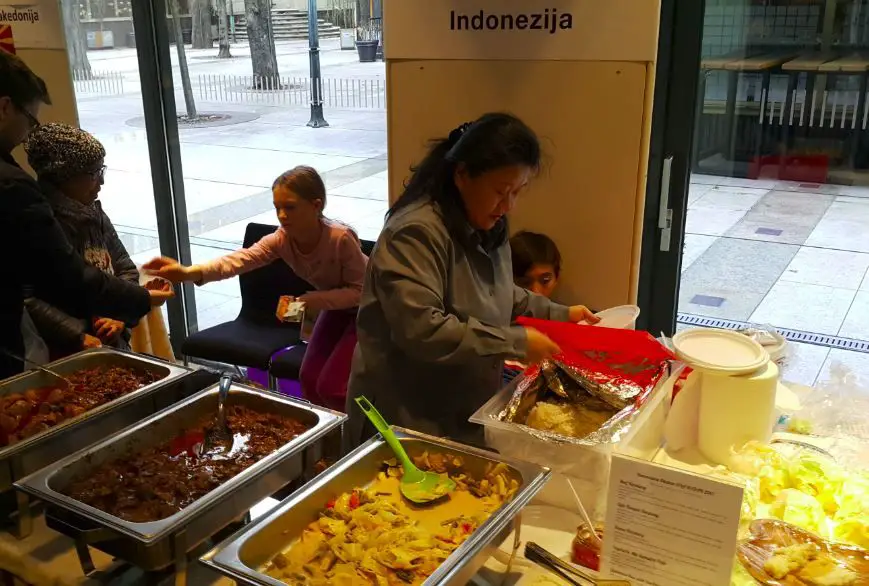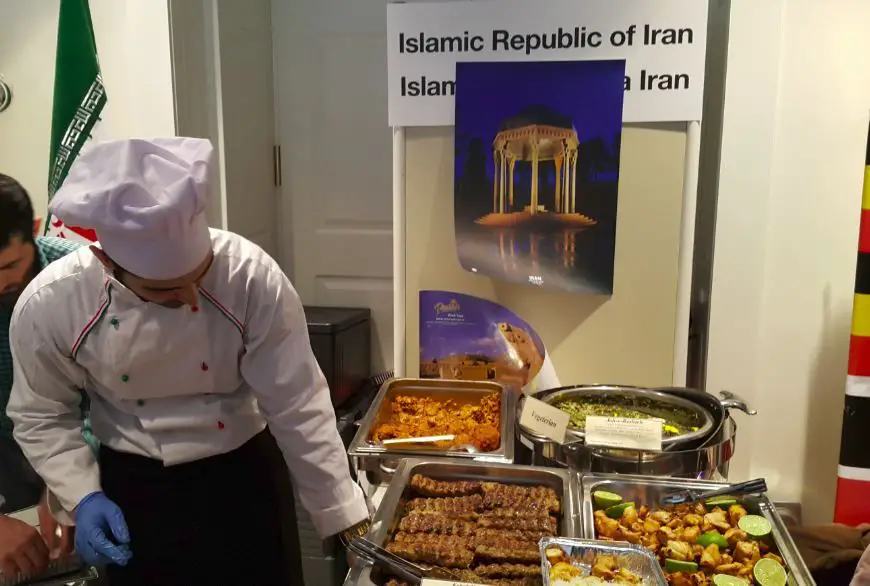Ljubljana related
In 2018 SILA – or SILA-IWCL, International Women’s Club Ljubljana, to give the full name – celebrated 25 years as a focal point for foreign women in Slovenia, as well as Slovenians who want to connect with the international community. But in doing so the group looked to the future more than the past, with the social changes that have taken place over the last quarter century increasingly reflected under the leadership of Marta Helena Berglez, along with greater engagement with a wider and more diverse community.
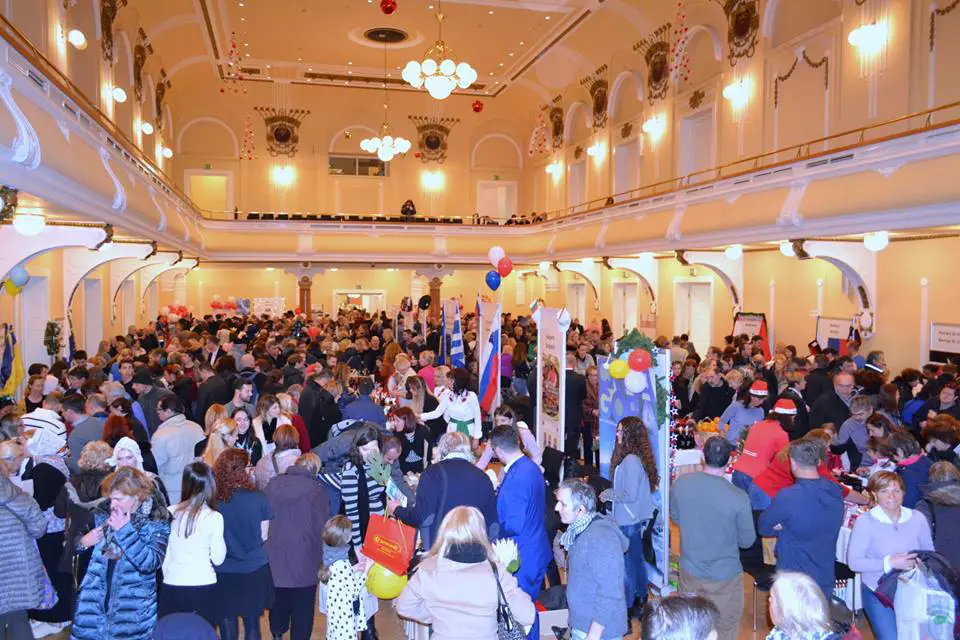
The annual bazaar
While SILA started as an association for the wives of diplomats and businessmen, who needed something to keep them busy while stationed abroad, it’s now shaken off the old image and is open to any and all women, no matter what their marital or professional status, Slovenes included.
As noted in an earlier article, SILA organises a broad range of events and activities for its members – cultural, sporting, educational and more – with the aim of bringing people together and making new connections, with each other and with Slovenia.
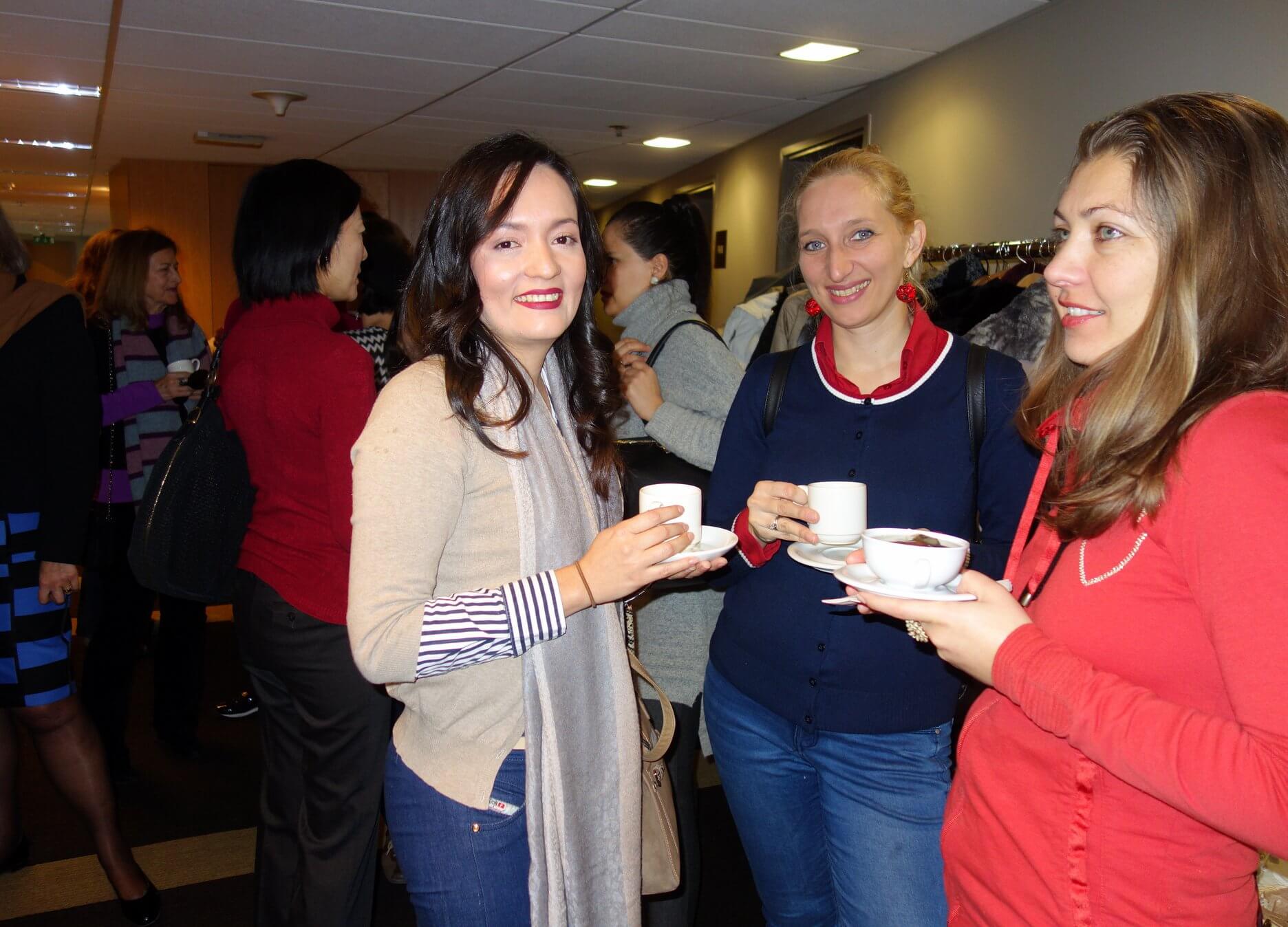
An important aspect of the latter is SILA’s charity work. This finds its greatest public expression in the annual bazaar, held each December in the ballroom of the Grand Hotel Union, but this year there’s a new event in the schedule, the Spring Soirée. This will be held on Saturday, March 30, and will present an evening of food, drink, music and dancing in diverse company, drawn together out of curiosity and all for the benefit of Europa Donna. This is an independent, Europe-wide organisation that represents the interests of women regarding breast cancer to local and national authorities, as well as to institutions of the European Union. The current vice-president of the group is Tanja Spanic, a Slovenian cancer survivor who will be one of the speakers at the evening, which aims to raise money from ticket sales (€55 each) and donations.
If you’d like to learn more and perhaps buy a ticket to Spring Soirée, or if you work for a company that might be interested in sponsoring a table and making a presentation to the guests, then you can learn more here.

If you can’t make it on March 30 then don’t worry. A good way to keep up with SILA and its activities is to follow the group on Facebook or visit its new webpage, while the best way is to join and start meeting new people and doing new things, opening up a world of opportunities in Slovenia, both personal and professional.
Fanny Susan Copeland was a remarkable person whose life serves as a curiosity and inspiration. A British woman who was born in Ireland in 1872, grew up in Scotland, and moved to Slovenia in 1921, where she spent most of the rest of her life, dying at 98 in 1970, and buried at the foot of Mount Triglav.
Although she wrote an autobiography it was never published and will remain in copyright limbo until 2020. One person who’s seen this memoir is Eric Percival, whose great-great-great-grandfather, Fred Holloway, knew Fanny’s father, Ralph Copeland, once the Astronomer Royal for Scotland, with the two men meeting near Manchester in the early 1860's. Percival put together the original post that sparked my interest in Ms Copeland, and also kindly supplied some of the pictures that accompany this story. Unless otherwise stated, the facts set out below are also drawn from his account of her life, as based on her own and other reports.
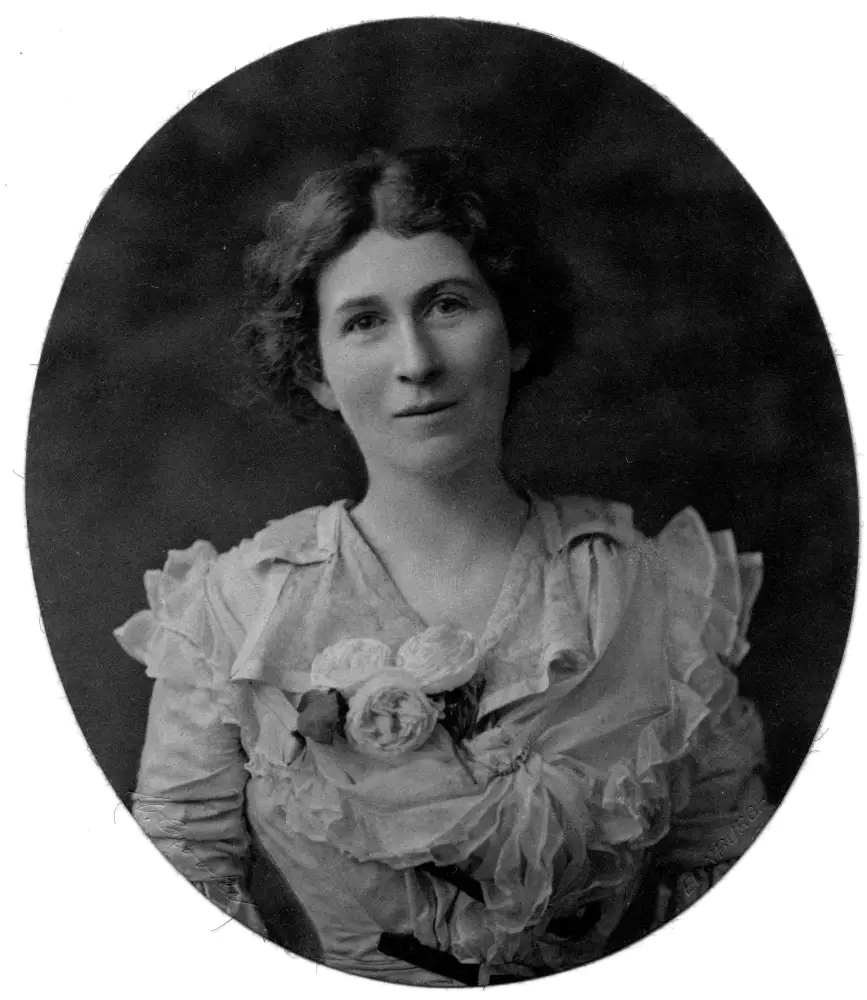
Although British by birth, Fanny was a thoroughly European woman, learning French and German as a child and being educated in Berlin shortly after turning 13. She also learned Latin, Italian, Danish, Norwegian and – due to her father’s interest in the Balkans – Slovenian. This connection with the country would be enough to get our attention, but Ms Copeland holds it because she bucks the standard narrative in terms of when and how one can make a new life for oneself. A brief outline of that life is as follows.
Fanny got married in 1894, at the age of 22, to escape her mother, but her husband was a 36-year old man who she never really liked. The couple had three children and then separated in 1908, finally divorcing in 1912, when Fanny was 40.
She developed a stronger connection with what would eventually become Yugoslavia soon after this, during the First World War, when she supported herself by doing translating for London-based South Slavic organisations. As part of this she translated Bogumil Vošnjak’s Bulwark against Germany: The fight of the Slovenes, the western branch of the Jugoslavs, for national existence, as well as serving as translator for the South Slavic delegation at the Paris Peace Conference.
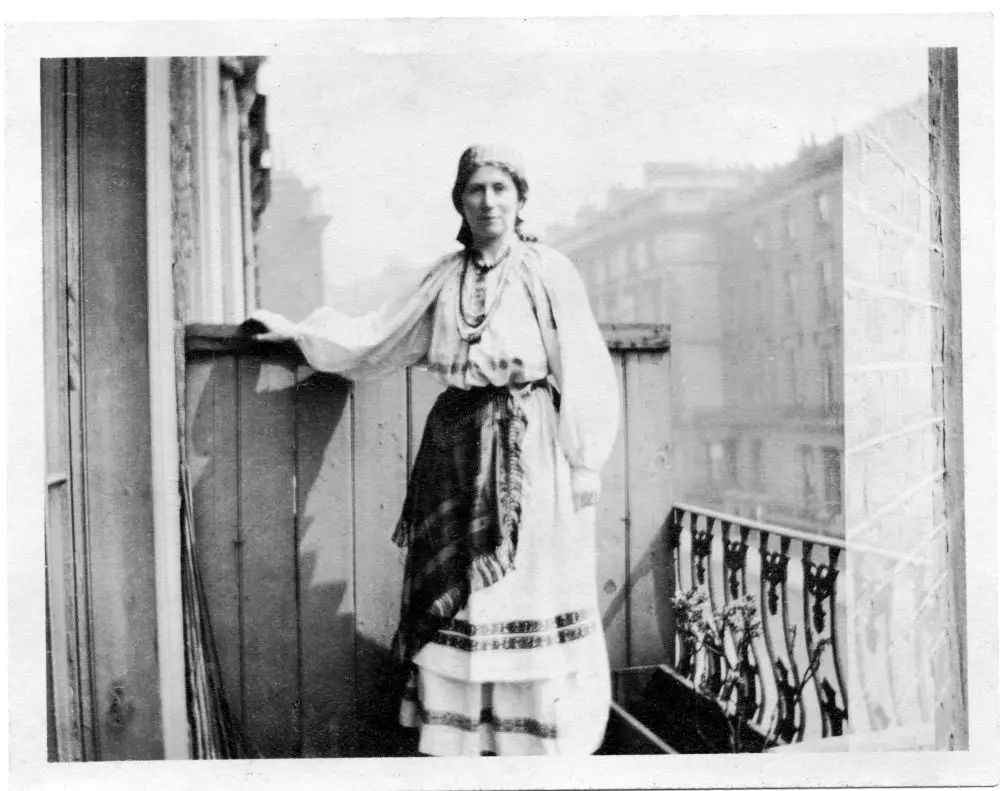
In "traditional costume"
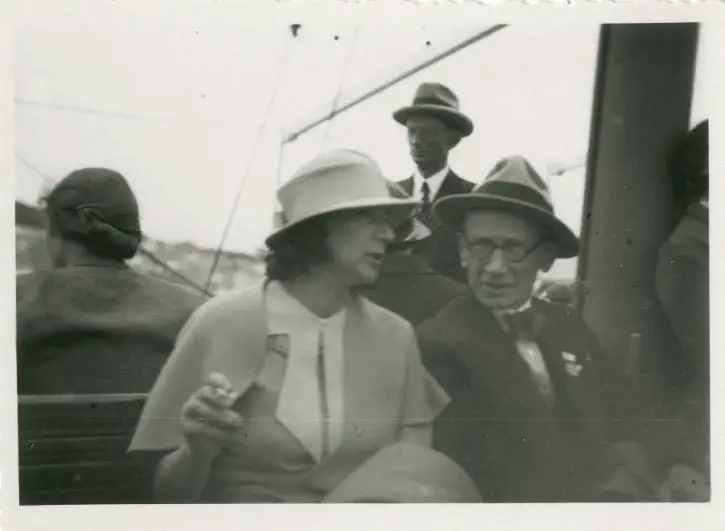
With Oton Župančič at the Congress of Dubrovnik in 1933
Ms Copeland then moved to Ljubljana in 1921, aged 49, when the city was part of the newly formed Kingdom of Serbs, Croats, and Slovenes. She was hired as a lecturer in English at the University (which itself only opened in July 1919), a post she held until 1941, when the Germans invaded. At this point, aged 69, she was arrested by the Gestapo and handed to the Italians, who moved her to Trieste, then to Arezzo and finally Bibbiena (in Etruria), where she spent the rest of the war “in open confinement”.
In 1953, aged 81, she finally moved back to Ljubljana. The death of her brother meant that she now had some savings, and thus Fanny Copeland lived in Hotel Slon for the rest of her life, continuing to work as a writer and translator.
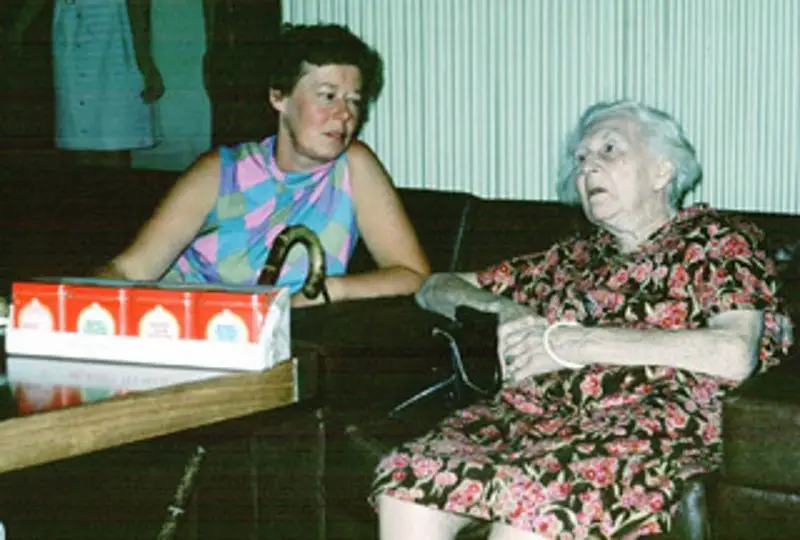
Ms Copeland, right, in the Hotel Slon, late 1960s
A pioneer of mountaineering tourism in Slovenia
But Fanny Copeland isn’t just a fine example of a person who didn’t let their gender or age dictate what they should be doing and when, or of someone who managed to successfully integrate themselves into a new country, as she also played a key role in the development of Alpinism as a local tourist offering, and in the promotion of Slovenia as a tourist destination. This section thus draws from an article by Janet Ashton called “Buried at his feet”: Fanny Susan Copeland, Triglav and Slovenia, and from another, Fanny Copeland and the geographical imagination, by Richard Clarke and Marija Anteric, both of which are recommended for more detail.
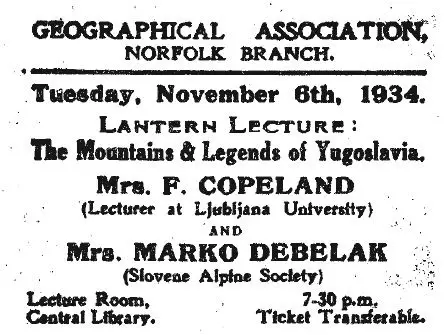
Ms Copeland felt a great attraction for the Julian Alps, and Slovenia the Slovenes in general, claiming they were the most Scottish of the Yugoslav communities, perhaps because of the mountains, long dominance by other powers, and characteristics of pragmatism and frugality.
She first climbed Triglav in the 1920s, not having taken up serious climbing until her 40s, and did so for the last time in 1958, just before her 87th birthday. She also wrote two books on the Julian Alps, Beautiful Mountains: In the Jugoslav Alps (1931), and A short guide to the Slovene Alps (Jugoslavia) for British and American tourists (1936). As she said in 1957, this was done in the “hope of attracting to Slovenia tourists of all types, from summer visitors in search of little-known beautiful and inexpensive Alpine resorts to Alpinists in search of accessible mountain ranges not yet wholly exploited or explored”.
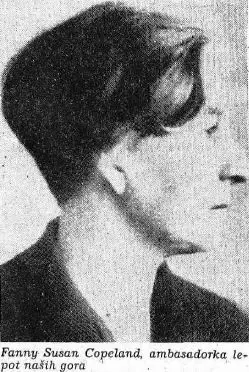
"Ambassador for the beauty of our mountains". www.gore-ljudje.net
Such efforts to reveal what in those days was still a very hidden gem were not without their obvious dangers, as she noted in a much earlier letter from 1923 when commenting on one of her many trips up Triglav: “It is an interesting walk, but as an expedition it is badly spoilt by the path having been made fool-proof. Result, every holiday is made hideous by hundreds of trippers, and the average person has to wait for a holiday to go up.”
Slovenski planinski muzej:- Fedor Košir, president of the Alpine Association of Slovenia and Fanny Copeland.
As mark of respect for her work to promote the Julian Alps, and to establish Triglav National Park, when Fanny Copeland died her funeral was organised by the Mountaineering Union of Slovenia. She was buried in the cemetery of the village church in Dovje, where you can still see her simple grave, as shown below.
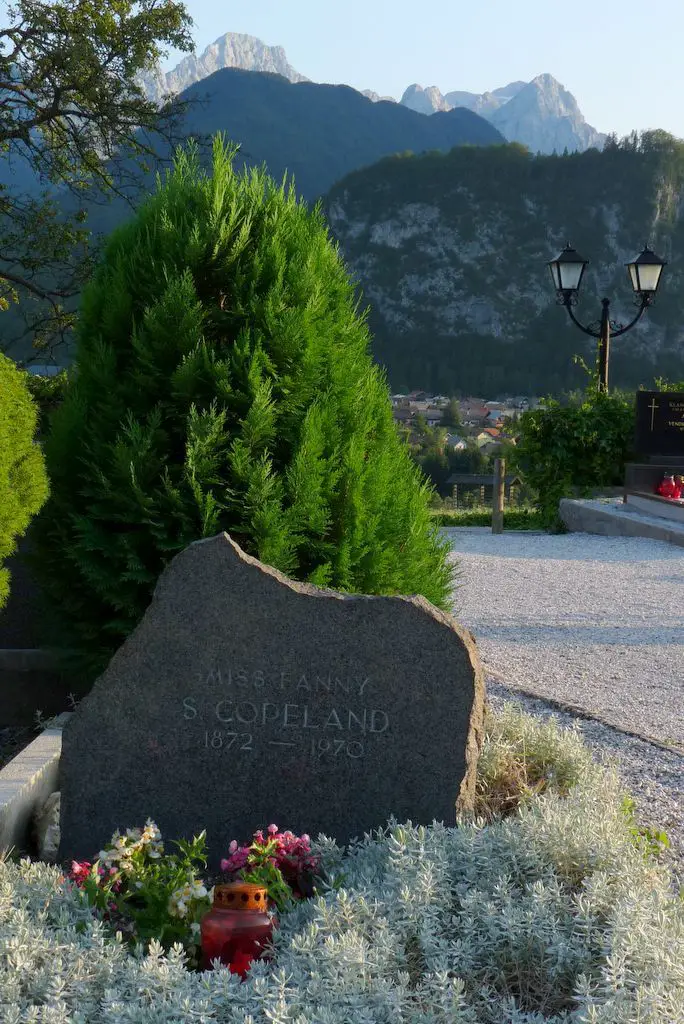
Wikipedia - Miran Hladnik CC-by-2.5
As Copeland wrote in 1931:
By fixed custom those that perish on Triglav are buried at his feet. In the pretty village church of Dovje, opposite the entrance of the stately Valley of the Gate (Vrata– truly a gate to be called Beautiful) they lie side by side. I think they would have it so. The long shadows of the regal avenue of peaks, down which they passed to their last adventure, sweep over their graves as the days and the years roll by; on All Souls’ day the mountaineers bring them pious offerings of prayer and lights, and from their tombstones their names cry greeting and warning to the hosts that go up year by year to visit the mountains, - greeting to the many who go up by the blazed trail where every danger spot is made safe with iron bolt and wire rope, to protect the unwary and put heart into the timid, - greeting to the few who seek, like themselves, to win the goal without guidance save the love of the heights, and no company except the extreme mysteries of life and death – greeting to the cragsman and the lover, to schoolboy and hunter, to smuggler and spy, and the ski-shod friend of the snows….
So if you find yourself in Hotel Slon, on Mount Triglav or by the village of Dovje, spare a thought for the remarkable Fanny Copeland, a woman who not only did as much as anyone else working in English to make the case for a separate Slovenian identity, one distinct from land’s association with the Habsburgs, Slavs and Serbo-Croatians, but also did much to bring the beauty of the land to a wider audience, and to share the best of her adoptive home with the world.
Postscript
As to what life was really like under Tito for a woman born to the academic elite under Queen Victoria, Copeland addresses this at the end of her autobiography, with a postscript to the reader:
But have you really found good reasons to go and live in a ‘communist’ state? This was a question I was often asked soon after my return to Ljubljana. Well - for one thing it depends on what you mean by 'Communism'. If you mean a totalitarian regime then my reply is that no Yugoslav would put up with such a system… The Yugoslavs are stout individualists, but they appreciate law and order. Ask any British tourist who has visited Yugoslavia in recent years.
All our stories on mountaineering in Slovenia can be found here
“This is a story about immigration. It’s a story about a Slovenian woman who left her village by Mt Krn in the Primorska region, to seek a better life…”
So begins the following documentary on Anka Makovec, who played an important role in preserving the Franklin River in Tasmania, and who also had much contact with the Aboriginal community, and especially their artists and poets. Of interest in and of itself, some readers will also enjoy the use of Slovenian with English subtitles (with the latter provided by Miha Mihelič).
Related: Meet the People - Miha Mihelič, River Rescue & Adventure Guide, in Bovec & Around the World
STA, 16 December 2018 - Slovenia has the largest share of women graduates in sciences, technology, engineering and maths (STEM) among all EU member states, show figures released by European Commission earlier this week.
According to the study Women in the Digital Age, the share of women graduates in STEM stands at 20.5 per 1,000 persons aged 20 to 29 in Slovenia, which compares to the EU average of 13.1 per 1,000 graduates.
The study brings an assessment of the participation of women in the digital economy, showing women lag behind men in several areas in the EU.
Only one in six information and communications technology (ICT) experts are women, and although women represent 52% of the EU's population, only 17% work in ICT.
However, data for the 16-24 age group are more encouraging, as the gap in digital participation between women and men is fairly narrow.
In the age group, 55% of women are active in the digital world compared to 60% of men, with the trend even starting to reverse in certain countries, with women outperforming men in the category.
Slovenia is the 10th best performing country in terms of integrating women in the digital sector, while the leader is Finland, with Bulgaria at the bottom of the list.
Slovenia performed best in specialist skills and employment (3rd place) and worst in the use of the internet (19th).
The Commission's first annual review of women's participation in the digital economy is based on the Women in Digital Scoreboard, which brings together 13 indicators in three fields: internet use, internet user skills, and specialist skills and employment.
It is to serve as a tool for the Commission and national governments to identify shortcoming and take action to improve the situation.
STA, 11 December 2018 - After being appointed acting police commissioner in October, Tatjana Bobnar was named for a full five-year term to the post by the government on Tuesday as the first woman to head the Slovenian police force.
Bobnar, who had previously served as deputy police commissioner since 2009, will assume her full term on Wednesday at a ceremony at the Police Academy in Tacen near Ljubljana.
Born in 1969, Bobnar joined the police force in 1993 as a crime investigator and rose through the ranks to first head the juvenile crime squad before being named the head of the operational support department and then assistant to the head of the Ljubljana Police Department.
She holds a master's degree in criminal law from the Ljubljana Faculty of Law, teaches at the Police College, and is a member of the programming councils of the Police Academy and the Faculty of Security Studies.
Bobnar was named acting police commissioner on 4 October to replace Simon Velički. Interior Minister Boštjan Poklukar did not give reasons for Velički's replacement, but unofficial information indicated the pair were personally incompatible.
For the first time ever Slovenia has women in command of the police force and the army. Major General Alenka Ermenc was appointed the chief of the general staff of the Slovenian Armed Forces last month.
In a recent interview with the STA Prime Minister Marjan Šarec said he was proud that the two forces were being headed by women. "Both are extremely capable and very committed to their work, which is what counts."
Related: Slovenian Army - Alenka Ermenc Becomes First Female Major General
I went to SILA’s annual bazaar for the first time last year and realised how foolish I’d been in not going before, and made plans to ensure not only that I’d be there this year, but arrive earlier and hungrier. It really is an event to look forward to, one in which the international community in Ljubljana takes centre stage to celebrate its diversity and start the festive season with a focus on charity.
Photo: Neža Loštrek
Photo: Neža Loštrek
As reported in a previous story, the Slovenian International Ladies Association, which this year is celebrating its 25th anniversary, was originally established as a social group for the wives of diplomats and foreign businessmen stationed in Slovenia. However, as times have changed so has the group, which is now open not only to any foreign woman living in Slovenia, but also Slovenes. SILA organises a full and varied programme of social, educational, cultural and sporting events for its members, but the focus of the year is its annual bazaar, which takes place this Sunday, December 2, from 10:00 to 16:00 in the ballroom of the Grand Hotel Union.
Related: Why you should consider joining SILA if you’re a woman in Ljubljana or nearby
Photo: Neža Loštrek
Photo: Neža Loštrek
There's Indian food.... Photo: Neža Loštrek
...Indonesian food... Photo: Neža Loštrek
...and Iranian food, and that's just the 'I's. Photo: Neža Loštrek
This year’s bazaar will be special one, since it marks SILA’s 25th anniversary, and the year in which the group received Slovenia’s “Order of Merit” medal from President Borut Pahor – also due to make an appearance on Sunday – for the good work it has done in the country over the last quarter century.
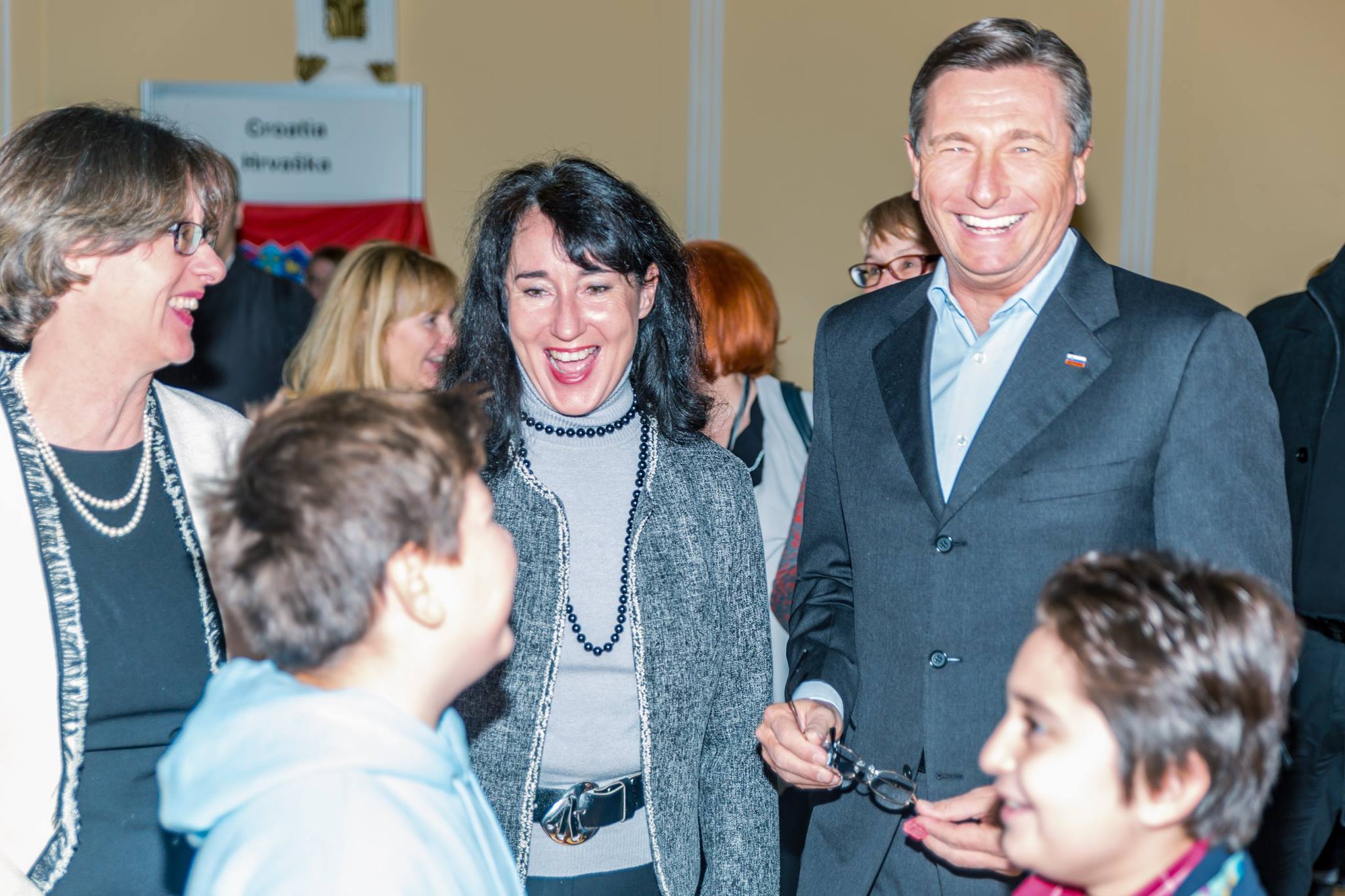
President Pahor at a previous bazaar. Photo: sila.si
Such work is the real focus of the bazaar, which raises money for charity. This year the targets are the elderly in different areas of the Slovenia, with the money raised from the event – including from a prize draw – being used to support projects sited in Jesenice, Novo Mesto, Krško, Slovenji Gradec and Ljubljana.
More specifically, the charities that any visitor to the bazaar will be supporting are:
Organisation ALTRA: Providing care, help and support for people with mental health problems and their relatives in Slovenia.
Ljudska Universa Jesenice and the project "Elderly for Elderly", supporting elderly people on low incomes.
The purchase of therapeutic devices for a home for persons with severe mental disorders in Novo Mesto
ASPI: An organization for adults with Asperger's syndrome and their parents.
School supplies for the children at Ljudska Univerza Krško.
MOCIS Slovenj Gradec, which needs furniture for a multi-generation centre.
Overall, SILA’s annual bazaar is a fantastic way to start the festive month, with food, music, colour, an international spirit and the opportunity to give back to, and be part of, the wider community in Slovenia, while celebrating differences and enjoying each other’s cultures. A highly recommended event, from 10:00 to 16:00 Sunday December 3, in the ballroom of the Grand Hotel Union (the entrance on Nazorjeva Ulica, next to the Atelje restaurant).
STA, 23 November 2018 - One hundred years after General Rudolf Maister established the first Slovenian army in modern history, Alenka Ermenc was promoted to become the country's first woman army general.
Slovenia celebrates Rudolf Maister Day on Friday in memory of the day in 1918 when the general (1874-1934) took control of Maribor and in effect secured what later became Slovenia's northern border.
The ceremony at which President Borut Pahor formally elevated Brigadier Ermenc to major general and decorated the association dedicated to the preservation of memory of General Maister was only one in several events marking the anniversary.
Pahor noted that a century ago Maister, "with his bravery and patriotic heart, preserved Maribor and the Lower Styria as Slovenian".
"One hundred years later, Slovenia is one of the world's safest countries. It is the merit not only of our defence force, but of society and country as a whole."
Pahor noted that Slovenia had to defend its independence with an armed force in 1991 and that Ermenc, who was made the first woman general today, was a member of the emerging Slovenian army then.
"This is a momentous moment for her, for the Slovenian Armed Forces, for our national and civic confidence, for our homeland and country," he said.
Putting on her new uniform of major general and accepting the Slovenian flag from the president, Ermenc said it was "the love for homeland" that guided her on her path, which was not always easy.
"I'm aware that the army is victorious only through joint effort and that the average never win," she said, underscoring the importance of knowledge and hard work.
Major General Ermenc studied in London, was in the independence war
Ermenc graduated from the Ljubljana Faculty of Social Sciences and from the Royal College of Defence Studies in London and got her master's degree in 2009 at the King's College University of London.
She was actively involved in the 1991 independence war as a member of the Territorial Defence, the army's precursor. She has been employed in the SAF for 27 years.
She was promoted to the rank of brigadier in May 2011 and in March this year she was named deputy chief of the general staff, the highest rank for a woman in the army.
Roughly one out of six members of the active component of Slovenia's Armed Forces are women (1,097 out of 6,658), including 188 civilians. As many as 301 are officers or non-commissioned officers.
Pahor also presented an Order of Merit to the General Maister Association and its founder Milan Lovrenčič for their efforts in the preservation of memory of the general and his contribution to Slovenia.
It was thanks to the association that 23 November has been observed as a public holiday since 2005, although not as a bank holiday. At the association's initiative the Maister Library of the University of Maribor, which keeps his books, has recently been declared a monument of national importance.
Ob dnevu Rudolfa Maistra je PRS in vrhovni poveljnik obrambnih sil priredil posebno slovesnost ob povišanju Alenke Ermenc v čin generalmajorke in vročil državno odlikovanje Zvezi društev general Maister in mag. Lovrenčiču. https://t.co/a4eYNg1n6I pic.twitter.com/dDE952kbRF
— Borut Pahor (@BorutPahor) November 23, 2018
Why Maister is the biggest name in Slovenian military history
Judging by his popularity, Maister is likely the most prominent military personality in Slovenian history. It is largely owing to him that Maribor, Slovenia's second city, and the north-east of Slovenia became part of the new Yugoslav state rather than Austria after the Austro-Hungarian Empire collapsed.
Maister was in command of the regional headquarters at the end of World War I and in 1918 assumed command of Maribor and the Slovenian part of Carinthia. He set up a Slovenian army of 4,000 soldiers, disarmed the German Schutzwehr security service, and disbanded the militia of the German city council.
The general then occupied Slovenian ethnic territory, establishing the northern border between Austria and Yugoslavia that was later ratified by the Saint Germain Peace Treaty. The same border still runs between Slovenia and Austria today.
The main ceremony marking the holiday was held in Maribor last night. In his keynote, Speaker Dejan Židan described Maister, a general and a poet, as a resolute, confident, courageous, selfless and honest patriot with the soul of an artist. He said people of his calibre were needed today.
"At the time it was about life and death. The situation called for quick decisions and actions, not just on Maister's part but on the part of everyone involved ... It wasn't until after Slovenia's independence that his historic merit was acknowledged by official politics." Židan said.
The ceremony was also attended by President Pahor and members of the government, including Prime Minister Marjan Šarec, who praised Maister as the epitome of bravery, determination and resolve.
An exhibition showcasing Maister as general and poet was launched at the National Assembly today. While wreaths will be laid at his grave in Maribor, Slovenian air force aircraft will fly over the city.
In keeping with a tradition launched by him, Pahor is holding an open door at the Presidential Palace today.
Predsednik Pahor je na predvečer dneva Rudolfa Maistra položil venec k spomeniku Rudolfa Maistra na trgu generala Maistra v Mariboru. pic.twitter.com/ZABRh0dlom
— Borut Pahor (@BorutPahor) November 22, 2018
Related: All our stories on Slovenian history are here
STA, 8 November 2018 - Brigadier Alenka Ermenc, deputy chief of the general staff of the Slovenian Armed Forces (SAF), will be promoted to the rank of major general as the first ever woman so high up the army hierarchy.
The proposal for Ermenc's promotion was endorsed by the government on Thursday after she was named deputy chief of the general staff in March this year, the highest rank for a woman in the army.
Ermenc graduated from the Royal College of Defence Studies in London in 2008 and got her master's degree a year later at the King's College University of London.
Before that she graduated from the Ljubljana Faculty of Social Sciences. In 1991, she was actively involved in the ten-day independence war as a member of the Territorial Defence, the army's precursor.
Ermenc has been employed in the SAF for 27 years. She was promoted to the rank of brigadier in May 2011. She holds a number military honours, including NATO Medal for participation in peacekeeping operations and the Maltese Order pro Merito Melitensi.
SILA – the Slovenian International Ladies Association, although sila in Slovene means “force” – started in 1993, before some of its current members were born, and has changed quite a lot since the days when mobile phones were the size of bricks and the country was only two years old. Some things, however, have stayed the same, and that’s the group’s two main aims: to provide a place where non-Slovene women can find support, companionship, adventure and get to know their new home better, as well as good work in the country.
STA, 10 October - An event in Ljubljana brought together on Wednesday the former and current participants in a state-funded programme promoting entrepreneurship among unemployed women. Entitled Entrepreneurship Is Female (Ženske in podjetništvo), the programme has so far provided courses and financial support to about 1,500 women, 90% of whom went on to start their own business.


